-

人教版新目标初中英语七年级上册What color is it说课稿2篇
该活动是为了加深学生对字母顺序的记忆。并在此同时学唱字母歌。要求活动前准备好火车头图案一个及字母歌磁带。在学生唱字母歌的同时,教师播放磁带。Arrive at the palace.( 进宫)到站了,字母客人经过一条由三张课桌垒成的地道后,来到一块写有“请过字母认读关”的牌前,一名交通警(由教师或学生扮演)出示字母卡片,让其逐个认读1—3个字母。凡认读过了关的到指定地点排好队。不能正确认读的经指导认读正确后去指定地点,准备上宾馆。该活动旨在训练字母的认读和发音。要求事先准备一块 “请过字母认读关”的标牌。Go to ABC Hotel. (上宾馆)已进城上宾馆的客人须在ABC Hotel(字母宾馆)内按编号拿取房门钥匙方可入内。这时带头饰大写A卡者拿取小写a卡,带头饰大写B卡者拿取小写b卡,其他人均寻找并取走相应的小写字母卡。

人教版新目标初中英语八年级上册Can you come to my party教案3篇
Step 3 (3b)First, tell the students when we talk about our future plans, we often use: I’m+verb+ing When we talk about what we must do, we use have to. Ask the students to fill in the blanks in 3b. The answers are: shopping, go to see, a test, I’m going, my family. Step 4 (3c)Let the students write an e-mail message to a friend. Say why you can’t visit next. Before the exercise, ask the students to give some possible answers and write them on the blackboard. So the students will feel easy to finish the writing exercise. After they finish it, Let them to correct it in groups first. Each group chooses theirs best one to read in front of the whole class. Step 5 ( planning a party )First read the conversation in the box together. Then ask the students to turn to page 88.Write down everything you have to do next week. Write in all the things you have to do . Ask the students to look at the list. Ask them “What day are you free?” This is when you can have your party. Step 6 (Self check 1 )Let the students to fill in the blanks with the words given. Change the forms of the words if possible. Then make their own sentences. The answers are: visit, playing, have to, study, comeStep 7 (Self check 2)Imagine you are Marie. Read the information and look at your schedule. Write replies to the invitation.
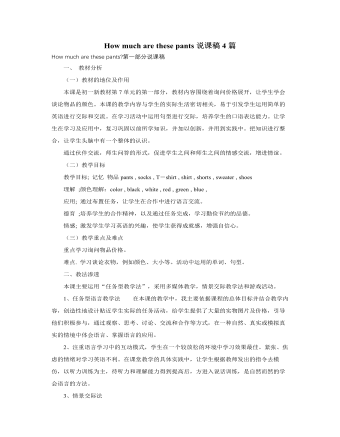
人教版新目标初中英语七年级上册How much are these pants说课稿4篇
3)情感目标在活动中培养学生的协作精神和竞争意识,培养学生学习英语的积极情感态度。同时教育学生要好好珍惜现在的学习机会,并养成勤俭节约的好习惯。3. 教学重点及难点根据本课在教材中的地位、作用及学生实际,我把“询问价格”及“购物时使用的礼貌用语”定为该课的重点和难点。二、教法根据教学目标、教材特点及学生的心理和年龄特征,我主要采用了任务型语言教学模式。创造性地设计了贴近学生实际生活的教学活动,吸引和组织他们参与交际活动,大大地激发了他们学习英语的兴趣,让他们在完成任务的同时,体验成功的喜悦。三、学法学习指导的目的在于使学生愿学、乐学、主动学、会学,在于促进学生的个性发展和全面发展。因此,在教学上,通过多媒体及活动等多种形式,教给学生观察事物的方法,并让学生在学中用,用中学。
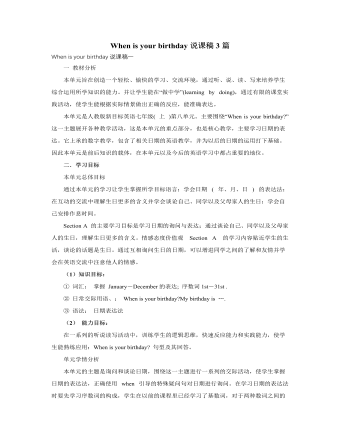
人教版新目标初中英语七年级上册When is your birthday说课稿3篇
一 教材分析 本单元旨在创造一个轻松、愉快的学习、交流环境,通过听、说、读、写来培养学生综合运用所学知识的能力。并让学生能在“做中学”(learning by doing),通过有限的课堂实践活动,使学生能根据实际情景做出正确的反应,能准确表达。本单元是人教版新目标英语七年级( 上 )第八单元。主要围绕“When is your birthday?”这一主题展开各种教学活动,这是本单元的重点部分,也是核心教学,主要学习日期的表达。它上承的数字教学,包含了相关日期的英语教学,并为以后的日期的运用打下基础。因此本单元是前后知识的载体,在本单元以及今后的英语学习中都占重要的地位。 二.学习目标本单元总体目标 通过本单元的学习让学生掌握所学目标语言;学会日期 ( 年、月、日 ) 的表达法;在互动的交流中理解生日更多的含义并学会谈论自己、同学以及父母家人的生日:学会自己安排作息时间。

人教版新目标初中英语八年级上册How was your school trip教案2篇
“Go for it!” is based on “Task-Based Language Teaching”. It adheres to “The authenticity principle”, “The form-function principle”, “The task dependency principle” and “The principle of learning by doing”. These principles all accord with the demands of curriculum focus.In and of Grade Seven (II), “Go for it!”, students have learned “The Simple Past Tense”. And it appears again in of Grade Eight (I). teaches students more about how to talk about events in the past. In addition, it gives affirmative and negative statements in the past tense, such as the sentence patterns “Did you see …?” “Were there …?” “Did you go …?” As the first part of Unit 8, Section A opens with a picture presenting the last school trip in the aquarium and continues with several step-by-step practice activities, which are all good for students to master “The Simple Past Tense”. Doing well in Section A will help students integrate the new target language with that in Section B. Thus, they can describe the events in the past freely and foster their own ability of reflecting and practicing. II. Teaching ObjectivesTeaching objective is the beginning and aim of teaching activities. According to the overall goal of the English elementary course--- improve students' synthetic ability of language application, which should be based on the development of students’ “Language knowledge”, “Language skills”, “Character building”, “Learning strategies” and “Cross-cultural awareness”. The teaching objectives are described as follows(I). Knowledge objectivesi. Master the simple past tense of regular and irregular verbsii. Recite the new words and expressions about the last school trip in the aquarium, including their pronunciation and intonation

人教版新目标初中英语八年级上册What are you doing for vacation教案2篇
Teaching goals : 1. Words & phrases: babysit ,get back , fishing , rent , think about , decide(on) , tourist etc. 2. How to talk about future plans . 3. 现在进行时表示将来计划或行动. 4. 特殊疑问句(where , when , how long引导) Important and difficult points : Drills :What are you doing for vacation ? I’m watching TV . When are you going ? I’m going … . How long are you staying ? We’re staying for five days . Teaching aids : cards and a tape ,a large wall calendar . Period 1 Teaching procedures : Step 1Leading in1. Free talk . 2. Put up the wall calendar . T: I’m staying home on Saturday (pointing to next Saturday ).Ss repeat . Ss: I’m staying home on Saturday . T: OK. Today we’ll learn how to talk about future plans. Step 2Pre-task SB Page 13 , 1a . 1. Look at the picture carefully and tell what you see in the picture . 2. Write the activities from the pictures in the box and add some more . 3. Practice reading . Step 3While-task1. Using the activities we write in 1a to make conversations .For example :What are you doing for vacation ? I’m visiting my uncle . 2. Pairwork .Practice in pairs . 3. 用第三人称练习对话.

人教版新目标初中英语八年级上册I’m more outgoing than my sister教案2篇
1 交通工具的比较此活动为小组活动。学生通过讨论找出到达某一城市可乘坐的各种交通工具,并选择最佳出行方式。Teacher:We’re going to Shanghai. How many ways can we use to get there? Yes, there are four ways: by bus, by plane, by train, by ship. Please discuss how you are going to get there.操作建议:(1)学生以小组为单位展开活动,谈论本组所选择的交通工具。(2)各组选代表向全班汇报,阐述本组所选择的交通工具的利和弊。完成任务所需要的语言结构:We can go there by ship. It’s more comfortable and cheaper than any other transportation.We can go there by bus. It’s cheaper but it takes longer time.2 哪个城市更合适?此活动具有挑战性。假设中国要举行2014年世界杯足球赛,分别从历史,人文,天气等方面对各城市(北京,大连,上海,昆明)进行比较,选择最佳举办城市。T: Imagine China is holding the 2014 FIFA World Cup. Which city do you think is the best for the World Cup, Beijing, Dalian, Shanghai or Kunming? Let’s work in groups. If you choose Beijing, please join the Team Red. If you chose Dalian, please join the Team White. If you choose Shanghai, please join the Team Blue. If you choose Kunming, please join the Team Green. Please show us its advantages. Then let’s see which team will win.

人教版新目标初中英语八年级上册What’s the matter教案2篇
She shouldn’t go to the party tonight.Step7. TaskT: You know, there are lots of problems in our life. If you are a doctor, please tell us how to solve the problem. I will divide you into 9 groups. Please work in groups. And then choose one of you to report your ideas.The following are the problems:I have a toothache.I am hungry. I have a sore throat.I am stressed out. I have a sore back.I am tired. I can’t sleep.I have a cold. I have a headache.Report: If you have a headache, you should go to bed early. You should see the doctor. You should eat some medicine. You shouldn’t wash your face with cold water.You shouldn’t sleep late.You shouldn’t swim.…..T encourages the students to give advice as much as possible.Homework:1. Chose one of the problems, and write down your advice2. Copy the new words这一步是用于热身的,同时也可以让他们复习一部分的表示人体部位的单词,扩充知识.学习语言的过程也是一个不断积累的过程,复习旧知识,增添新知识.通过小游戏,强化学生对Does she/he have…这个句子的运用能力.通过复习,自然的引到下面新知识的学习。充分利用表格,由句子到对话,再到文章,让学生循序渐进. 提高学生的综合语言运用能力,运用以前学过的知识来解决身边的问题.Period 5 (Section B 3a—3c, selfcheck)教学内容与分析:
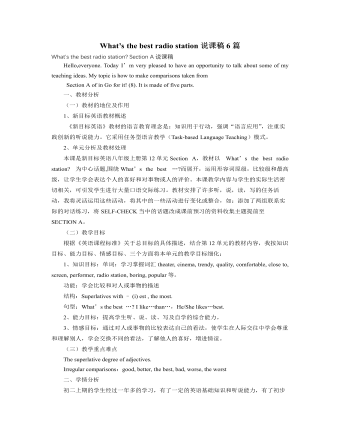
人教版新目标初中英语八年级上册What’s the best radio station说课稿6篇
3、重点和难点:重点:学会用形容词的最高级来对事物或人物进行描述。难点:形容词的最高级加est还是加most.二、 说教法:为了更好的突出重点,突破难点,我主要采用了:1、任务型教学法:新课标倡导的“玩中学,学中玩”的理念很受学生欢迎。例如,阅读文章时,我设计了一张表格,让学生阅读后完成表格并复述。培养学生逻辑分类与表述能力。2、 竞赛教学法:根据初中生争强好胜的性格特征,我每堂课都进行俩俩对话,激发学生兴趣,给学生创造外语语言氛围,培养学生集体荣誉感。三、说学法:1、 善于抓住用英语交际的机会,充分感知,积极体验,大胆实践。例如在导入新课时的One minute dialogue(每组都有一次机会),pairwork (每人都有机会),groupwork(每组一次机会)。2、 积极参与,善于合作。例如本课设计了几个任务,操作简单,学生一定很感兴趣并且积极参与,从而合作完成任务,培养了团队精神。
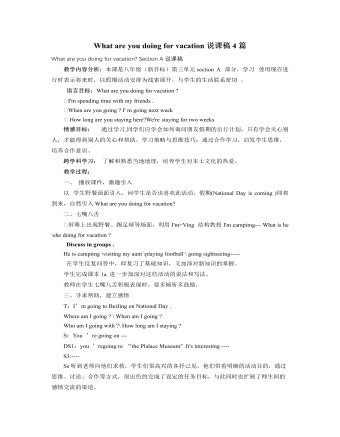
人教版新目标初中英语八年级上册What are you doing for vacation说课稿4篇
这一环节我采用电影《哈利波特》中哈利去霍格华兹的图片引入“how does Harry go to school?” 进而引入” how do you go to school?” 呈现“the ways to go to school” 让学生明确take 的使用及与交通工具的搭配。接着让学生根据实际情况回答自己采用的交通方式,期间可以引入“how does he /she go to school?” 基本了解了怎么说后进入课文,完成1a 部分练习 和1 b 的听力练习。完成后让学生玩一个数字游戏,帮学生回忆数字。通过问学生从家里出发时间和到达时间,引出“it takes ?? minutes .” 的句型。借助ppt 图片进行句型操练。然后完成听力练习2a—2c。本环节用时20分钟。While-task:本堂课的主要任务是让学生运用已学的语言知识,完成一个任务,即计算从学校到上海各种交通工具所需要的时间和费用,讨论应选用和种交通工具和各种优缺点。这一环节将用时10分钟。
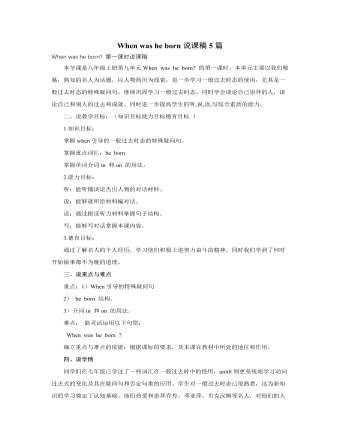
人教版新目标初中英语八年级上册When was he born说课稿5篇
1. 教学重点(1)新单词及目标语言的掌握。(2)听、说、读、写的综合训练。(3)对对合作及小组合作练习口语的训练。2. 教学难点(1)when所引导的特殊疑问句。(2)询问生日与出生年月日的区别。When is your birthday? (一般现在时)When were you born?(一般过去时) (3)表达年月日时所用的不同介词:in+年/月;on+日期二、教学方法。由浅入深,由易到难,由已知到未知,从学生熟悉的运动明星、电影明星甚至是歌手入手,调动他们的学习积极性,让他们在心情愉快、兴趣浓厚的氛围中展开一系列听说读写的训练,主动地投入到学习中去,自然地掌握本单元的重点、难点;循序渐进地深化教学内容,同时以训练学生听说为主,展开以老师为主导,以学生为主体的师生双边互动活动。三、教学手段。利用名人图片来辅助新的语言知识的巩固和训练;采用多媒体教学,并把听力内容录到电脑中,锻炼了学生的视听能力,提高了教学效果。

人教版新目标初中英语九年级上册Teenagers should be allowed to choose their own clothes教案2篇
Step 1 Greeting Greet the class and check the homeworkStep 2 A duty report The S on duty gives a report on the rules in his home and lead in 3a “Sun Fei’s and Wu Yu’s rules” Step 3 ReadingSs read the conversation and write the two girls’ rules in the chart. Check the answers.Get Ss to read after the tape and then read aloud by themselves. Then, T explains the language points.Step 4 Pairwork 3bRole play. Use the information in chart to practice with the conversation in 3a covered. They can look at the sample conversation in the right box.Step 5 Task 2 “Who’s the best reporter?”Make a survey by asking any 5 students the questions in the chart in activity 4. Then give out a report about it. See who is the best reporter? And the best reporter will get a nice ball-pen.Step 6 Summary and homework:Write out the report in your exercise-books.Period ThreeStep 1 Greeting and a duty reportThe S gives a duty report talking about his experience of being late for school. Lead in the question “Do you ever get to school late? How often do you get to school late? Always, usually, sometimes, or never?Step 2 1a Get Ss to finish writing.Step 3 Pairwork 1b Get Ss to talk about their answers with their partners using the sample conversation in the box on the right.Step 4 Listening practice2a Lead-in: What will happen if you get to school late? What about Peter? Let’s listen to a conversation between Peter and his father. Get Ss to finish 2a (As usual, for the first time, Ss only listen.) Check the answers.

人教版新目标初中英语九年级上册How do you study for a test教案2篇
内容提示本单元主要内容是学会利用verb十by/with gerund表示方式方法来讨论学习英语的策略,认识自己在学习方面的长处和不足。初步了解现在完成时的结构和用法。现在完成时由助动词have/has+动词的过去分词构成,主要表示过去发生的某一动作对现在仍有影响或造成的后果,常与already,yet,just,ever,never等副词连用。教学目标一、学习目标(Language Goal) 1. Talk about how to study . 学会讨论各种学习方法和策略。2. Find out your suitable learning methods. 找出适合自己的学习方法。 二、语言结构(Language Structures) 1. Verb + by with gerund by+动名词短语 表示“通过…途径,方法” 2. How questions have引导的特殊疑问句 三、目标语言(Target Language) 1. How do you study for tests ? 你是怎样准备考试的?Well , I study by working with my classmates. 哦,我和同学们一起学习。2. Have you ever studied with a group ? 你曾经参加过学习小组吗?Yes , I have . I’ve learned a lot that way . 是的,参加过。通过这种方式我学了许多。

人教版新目标初中英语九年级上册Where would you like to visit教案2篇
The First PeriodⅠ.Teaching Aims and DemandsKnowledge Objects(1) Key Vocabularytiring, educational, fascinating, thrilling, peaceful, exotic, trek, jungle, take it easy, explore, historic, site(2) Target LanguageWhere would you like to go on vacation?I’d like to trek through the jungle, because I like exciting vacations.2. Ability Objects(1)Train students to talk about places they would like to visit with the target language.(2)Train students to describe vacations with different adjectives.(3)Train students' listening skill.3. Moral Object,It′s more interesting to go on vacating somewhere instead of staying at home.Ⅱ. Teaching Key Points1. Key Vocabularytiring, educational, fascinating, thrilling, peaceful, exotic, trek, jungle, take it easy, explore, historic, site2. Target LanguageTalk about different places with the target language.Ⅲ. Teaching Difficult Points1. Describe vacations with different adjectives.2. Talk about different places with the target language.Ⅳ. Teaching Methods1. Teaching by illumination2. Teaching by doing chain drills3. Teaching by pairworkⅤ. Teaching Aids1. A tape recorder2. Some pictures of different places with famous views
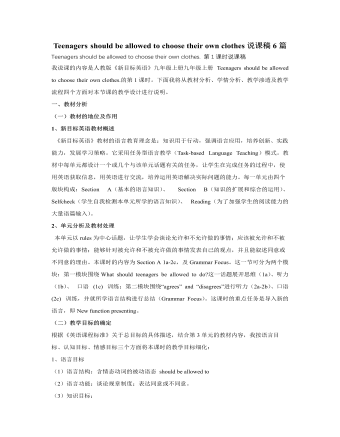
人教版新目标初中英语九年级上册Teenagers should be allowed to choose their own clothes说课稿6篇
二、教材分析本课时主要是以听和说的方式来谈论一些家庭和学校的“规矩和制度”,知道那些时可以做的,那些是不可以做的,让学生先从口头上了解这些规矩和制度,为后面的学习做好准备。三、教学的目的和要求1. 掌握短语be strict with sb.的用法,并介绍be strict in sth.的用法;2. 学生能够根据所学的知识,了解用什么方式/句型来制定规章制度。3. 多听,提高学生的习愿望,敦促学生开口说英语,用本课所学的知识来表达自己的意见。四、教学重点和难点1. 如何正确使用be allowed to do…这一句型(在不同时态中的被动语态运用)。2. 如何获得听力技巧及口语技能的提高。五、教学过程T—teacher S—studentS s—students Bb—blackboardStep 1 Warming up Check their homework first, and see if the Ss can make sentences by using the rules in 4, Section A. If possible, try to give some help.
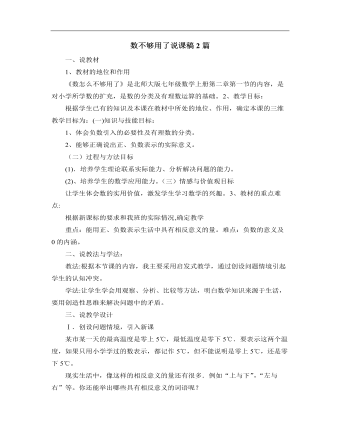
北师大版初中八年级数学上册数不够用了说课稿2篇
(3)在某乒乓球质量检测中,一只乒乓球超出标准质量0.02克,记作+0.02克,那么-0.03克表示什么?解:(1)扣20分,记作-20分;(2)沿顺时针方向转12圈记作-12圈;(3)-0.03克表示乒乓球的质量低于标准质量0.03克。4、让学生回顾现已学过的数,将他们进行分类,最后教师总结。(三)课堂练习,及时反馈为了让更多的学生参与进来,通过练习巩固知识发现不足,教师及时得到反馈,检查教学效果,采取相应措施,我采用了一下习题:(电脑演示)在练习过程中培养学生养成用所学知识去思考问题、判断问题、解决问题的好习惯。学生的练习分出了梯度,让不同学生的学生都有所提高,有助于贯彻因材施教的教学原则。各组练习在进行中,进行后,都要掌握学生的完成情况,让学生举手,加以统计,及时纠错及再讲解。在学生回答问题时,我通过语言、目光、动作给予鼓励与告诉,发挥评价的增益效应。
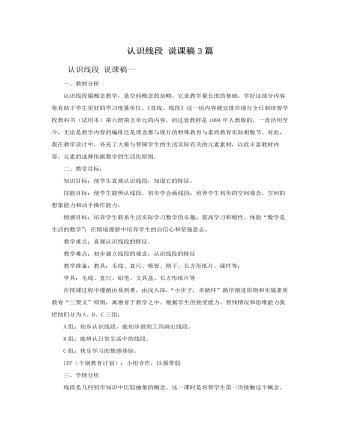
人教版新课标小学数学二年级上册认识线段 说课稿3篇
一.创设情境,解决问题。(一)直观认识1.请每个同学举起手中的毛线。说说你的毛线和其他同学有什么不一样。(学生会观察到有长短,颜色,粗细的不一样。)设计这个环节是为了让学生先找出线段的非本质特征。只有去掉了非本质特征,学生才能更明确到记住线段的本质特征。)2.请每个同学在认真观察,说说你的毛线和其他同学的有什么是一样的。这个环节学生最基本能发现手中的毛线是直的。(二).讲解概念1.通过直观的认识后,由教师讲解线段这个概念:像我们刚才手中这一条直直的毛线,就可以看做是线段。(这句话的讲解中,教师要突出直直的,这是线段的最基本特征,还有一个词是是看做是,数学的是严谨的,不能说这条毛线是线段,并让学生也举起毛线和老师一起说说这句话。)
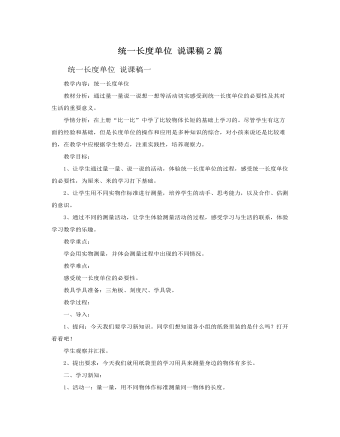
人教版新课标小学数学二年级上册统一长度单位 说课稿2篇
教学内容:统一长度单位教材分析:通过量一量说一说想一想等活动切实感受到统一长度单位的必要性及其对生活的重要意义。学情分析:在上册“比一比”中学了比较物体长短的基础上学习的。尽管学生有这方面的经验和基础,但是长度单位的操作和应用是多种知识的综合,对小孩来说还是比较难的,在教学中应根据学生特点,注重实践性,培养观察力。教学目标:1、让学生通过量一量、说一说的活动,体验统一长度单位的过程,感受统一长度单位的必要性,为厘米、米的学习打下基础。2、让学生用不同实物作标准进行测量,培养学生的动手、思考能力,以及合作、估测的意识。3、通过不同的测量活动,让学生体验测量活动的过程,感受学习与生活的联系,体验学习数学的乐趣。
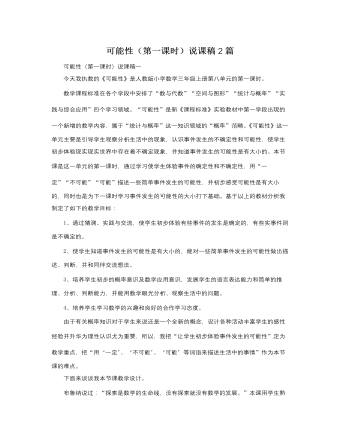
人教版新课标小学数学三年级上册可能性(第一课时)说课稿2篇
在教学中我力求做到以下几点一、体现“活动性”,让学生在活动中体验。《新课标》明确指出:“让学生在具体的数学活动中体验数学知识。”因此,我在新授部分以学生喜欢摸子活动开始,以期激发他们学习的热情和兴趣,使学生在活动过程中感知“一定”、“可能”、“不可能”,进而能判断生活与数学中的“一定”、“可能”、“不可能”这三种情况。并能用自己的语言描述事情发生的三种情况;(然而在课堂中,让学生把这三个词语放在一起例举数学与生活中的实例吧,学生说起来还是有一定难度的,所以在教学中我只有通过自己先举例在让学生说,这时学生才能说出例子来。)最后又让学生小组合作学习感知体验可能性是有大小的,达到巩固与应用的目的。
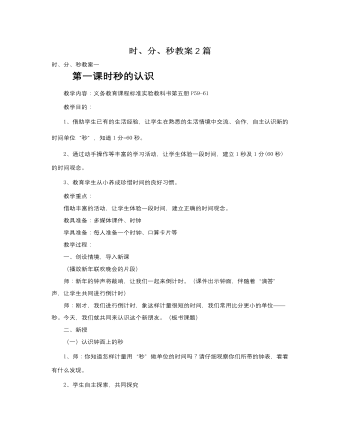
人教版新课标小学数学三年级上册时、分、秒说课稿2篇
教材分析这部分内容是在认识钟表上的整时、半时的基础上进一步认识钟面上的时、分。分是非常重要的时间单位,也是进一步学习年、月、日的基础。时间单位不像长度、质量单位那样容易表现出来,比较抽象,学生不容易理解。所以,应以学生的生活经验为基础,把学习内容与学生的生活实际密切联系起来,进行教学。“我们赢了”是结合“北京申奥成功”这一情境,让我们记住这一历史时刻——2001年7月13日晚上10时08分。用记载着这一历史时刻的钟面,引导学生交流自己对钟面的认识,激活学生已有的生活经验;同时,抓住机会渗透爱国主义教育,引导学生关注社会,关心时事。学情分析学生在一年级时已经学过了钟面的简单知识并会认识整时和整时半。但有关时间的认知显得有些混乱,对时针和分针表示的意义分辨不清,多数孩子还不能读出准确的时刻。